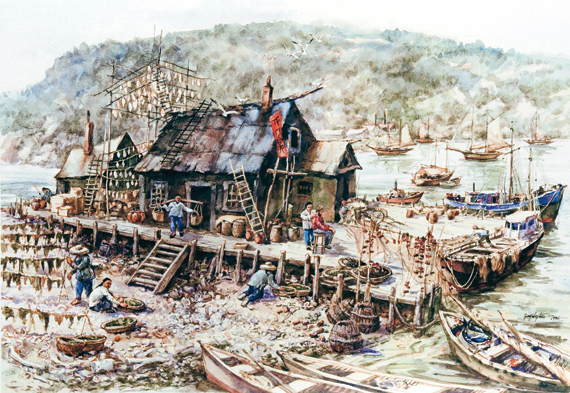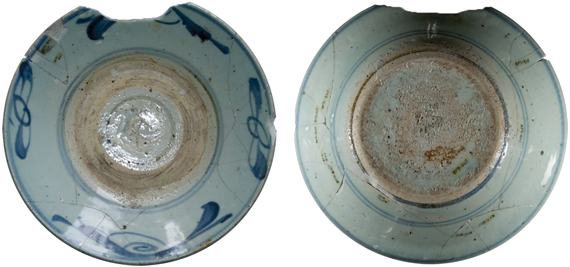|
San Diego's First Chinese Community
Early Fisheries on Ballast Point at the Harbor's Edge
By Ronald V. May
With the crowing roosters and gradual rays of sunlight peeking through doors and shutters of Old Town San Diego, the Chinese fishmonger's cries heralded a typical morning in 1860's San Diego. Each day began with Chinese peddlers knocking on doors to sell the morning catch from buckets balanced on yoked shoulders. Family cooks selected from a wide variety of bocaccio, corbina, sheepshead, bass and perch brought in from the Point Loma kelp beds and offshore reefs some five miles distant.
Undoubtedly, the first Chinese settlement developed at Ballast Point where Prince William and Alphaeus Packard built a whaling station. The Los Angeles Star provided the earliest report of Chinese junk anchored in San Diego Bay in 1861. That same year, Ephraim Morse recorded that Ah Sing purchased supplies at the Old Town Mercantile Shop, and Lucy Wentworth, a Ballast Point whaler's wife, later recalled that Juk and Ah Sing "made lots of money selling fish" from their Ballast Point home in 1867. This small community was first recorded by the Tax Collector in 1863, as having owned boats and nets. The 1865 list showed that Ah Yu of Ballast Point owned a schooner worth $75 and seines worth $20; the following year Ah Sing owned 350 gallons of oil and other property worth $197.50. By 1870, the community had grown considerably and included Ah Soy, Ah Pun, Ah Fry, and Ah Hung and their families, all of whom traded at the Old Town Mercantile Shop.

Fine artist Jay Wegter reviewed evidence recovered from the 1988-1992 Ballast Point excavations in order to interpret how the Chinese fishing community might have appeared. Photographs from the Bancroft Library of a Chinese fishing camp at Monterey provided guidance on the housing styles; the hills of Point Loma in the background are depicted from modern photographs. Courtesy Fort Guijarros Museum Foundation
When not working at the Ballast Point Whaling Station, the Chinese harvested coastal resources for commercial use. Eggshells recovered in archaeological excavations reveal that wild bird eggs and abalone meat were included in the diet. Bits of brass sheet, tinned oil cans, and scrap metal were refashioned into kitchen domestic items such as ladles and canisters. But it was the abalone shell that ultimately rose in importance on Ballast Point.
The Ballast Point Chinese kitchen refuse feature is the single-most important reference for early Chinese culture in San Diego. Analysis revealed 1860s vintage broken porcelain and miscellaneous stoneware, bamboo bowls, brown-glazed coarse stoneware utility jars and soy sauce bottles, a few bits of opium pipes and Asian medicine bottles, and mixed English and European American plates, cups, and bowls. A few whale bone fragments mixed with cleaver-cut cattle, sheep, and pig bones linked the deposit to the nearby Ballast Point Whaling Company. Census documents record the Packard Whaling Company as including Ah Low, the company cook, in 1870.

This Southeast Asian Fu plate represents the secondary business of barbering the Chinese at Ballast Point provided the European American whalers who lived less than 100-feet away. The notch has been ground smooth and matches barber bowls used by Europeans to bleed bad spirits or ghosts from their bodies when they got sick. This practice was alien to Chinese culture, but common on the 19th Century American frontier. The Fu plate itself actually dates from the late 17th Century and may have been an heirloom brought to America by the Chinese. Photos by Ronald V. May
The Chinese also gathered seaweed and dry abalone to ship back to China. High frequencies of tiny limpet and scallop shells, which attach to floating kelp, were found, evidence of a kelp drying operation on Ballast Point at the Chinese fishing camp.
U.S. Army plans for post Civil War defense of San Diego doomed the Ballast Point Whaling Station and Chinese fishing camp. Lt. Thomas Handbury of the U.S. Army Corps of Engineers conducted a land survey of Ballast Point to create contour maps for the design of Fort San Diego. Handbury reported "on Ballast Point there are at present a few old huts occupied by whalers and Chinamen." In 1872 the whalers and Chinese were evicted and construction began of a huge earthen fortification.
Presumably, these huts were dismantled for reconstruction one mile north at La Playa. A federal fisheries account described this as ten to twelve unpainted shacks positioned in two rows at right angles to each other, racks for drying fish and outhouses. More Chinese joined this community following construction of the California Southern Railroad in the 1880s.
Chinese fisheries operations extended hundreds of miles beyond Ballast Point and San Diego. The strategy of exploration and relocation from wooden junks is deeply ingrained in Asian coastal industries. Relocation from Ballast Point to La Playa probably had little effect on the growing industry. Throughout the 1860s, whaling and Chinese fisheries were intertwined with shared equipment and leased boats. For example, the Packard Whaling Company sloop-rigged New Hope shipped eight tons of abalone meat from Santo Tomás, Baja California to San Diego in 1871 and ten tons from San Quintín, Baja California were shipped on the whaling schooner Emma Hayne, which returned the following day with "Chinese employed for the abalone harvest... a large lot of rice and Chinese cured pork for the sustenance of the fishermen."
Following eviction from Ballast Point in 1873, fishing and abalone harvesting expanded all along the California coastline from Point Loma to Cabo San Lucas, Baja California, and out to San Clemente and the Los Coronados Islands. San Diego abalone fishermen led the State in the harvest, which produced 700 tons annually by 1880. Eighteen junks ported in San Diego conducted the extensive abalone trade.
By 1884, the community of La Playa had transformed into Louis Rose's housing subdivision of Roseville. A Chinese boatyard produced large redwood junks and smaller sampans for the fishing industry. The large three-masted Sun Yun Lee was built in 1884, and measured 52-feet long with a capacity of 14.6 tons. The smallest Roseville junks carried five tons.
At least twelve Chinese fishing companies operated out of San Diego. They worked right alongside four Euro-American companies with little friction. Arthur F. McEvoy would later remark:
In San Diego, the fishermen purchased lumber for their boats and houses from local suppliers and traded with local merchants for rice, hardware, and other supplies...relied on white shipping agents and the Pacific Mail Steamship Company for getting their harvests to Chinese distributors in San Francisco. Abalone shells, which were produced for an American market, were sold to American merchants who sorted and finished them for export.
By 1881, a third Chinese community developed among the wharfs of New Town. Located several miles inside San Diego Harbor in the Stingaree District, this neighborhood would absorb all the fisher folk of Roseville by 1886. The draw that depopulated the La Playa/Roseville Chinese community was a building boom in New Town, coupled with railroad construction. The Chinese supplied both labor and sea food for the flood of European settlers into San Diego. Tons of fish, clams, and oysters were sold in these markets.
But the rise of European Americans in San Diego coincided with anti-Chinese sentiments across California. A series of federal and state laws destroyed the Chinese fishing industry in San Diego and by 1888, only 52 of 159 fishermen in San Diego were Chinese.
The surviving Chinese fishing companies relocated their operations on San Clemente Island and in Baja California in 1887. Larger boats anchored off shore and small sampans and lighters shuttled products to the San Diego waterfront. The Scott Act of 1888 invalidated Chinese certificates of residence and further broke up the abalone fishing industry to the point that only six junks operated by 1890. The last of these junks wrecked in Ensenada, Mexico in 1900.
No map record exists of the Ballast Point Chinese fishing camp, the fate of Juk and Ah Sing, or Ah Low the cook. The only tangible record of that small community is the archaeological remains recovered in 1991 when removal of the 1890 brick foundation of the Ballast Point Light House revealed that the beach at that time was covered with clear gray beach sand. All memory of the Chinese fishing camp at Ballast Point had been washed over by the sands of time.
About the author With over 35 years experience in historic, archaeological, and general environmental studies in California and northern Baja California, Mexico, Ron May has written over 50 publications on these and other topics that include government policy and Spanish historic ceramics. An Architectural Research Historian, Ron is also President and co-founder of Legacy 106 Inc. and Chairman of the Fort Guijarros Museum Foundation.
|
MORE FROM THIS ISSUE
From the Editor
Warner-Carrillo Ranch House
Santa Ysabel General Store
The Hawaiian Connection
San Diego's First Chinese
Community
Temple Beth Israel
Archaeological Myth Busting
Chicano Park & its Wondrous Murals
Sleeping Porches & Suffragist
Banners
Most Endangered List of
Historic Resources
Windemere Cottage
People In Preservation Winners
In Memoriam
Preservation Community
Recent Acquisitions
Save Balboa Park
Lost San Diego
Strength in Numbers
Donations 2010-2011
Advertisements
DOWNLOAD full magazine as pdf (11.3mb)
|





